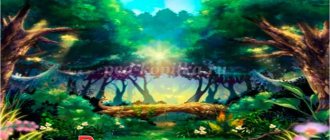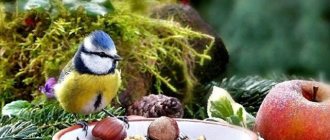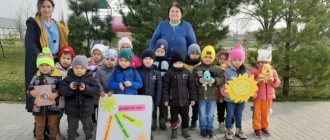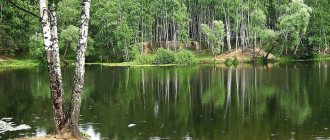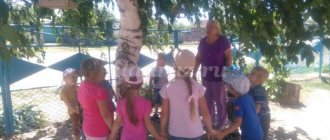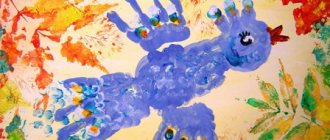Tales about birds. Woodpecker.
Why is the woodpecker respected by all birds and animals? And what would happen if woodpeckers disappeared? This is talked about in the fairy tale “The Woodpecker.”
Woodpecker worker. Tales of Lake Baikal
Birds from all over the taiga flew in and began to scold the woodpecker.
The cuckoo is the angriest of all: “You give me no peace, woodpecker, you knock, you knock!”
“Your knocking makes my head hurt,” the nutcracker complains.
- Idlers, you have ready-made food: flies, mosquitoes, boogers, berries, tree buds, nuts. And I need to chisel the tree, look for beetles under the bark. I save you all, ungrateful ones, I work from morning to night!
The birds whistled, chirped, and chattered angrily: “What!” Are you saving us? - Look, what a braggart! - Let's peck him!
The din of birds was interrupted by a capercaillie - an important bird in the taiga, it does not throw words to the wind. He stamped his foot: “You shouldn’t make a fuss, the woodpecker told the truth!” It protects trees from greedy bark beetles. Without it, they would have devoured all the trees and devastated the taiga. How can we live without the taiga?.. Screamers!
The cuckoo, sitting on a tall pine tree, was the first to sing throughout the whole taiga: “Pucko-coo, woodpecker, peek-a-boo, darling!”
Behind her is a nutcracker: “I praise you, buddy.” Come on - knock, knock.
- Knock-knock - good sound! - the forest pigeon shouted loudly.
The birds surrounded the woodpecker, the violator of the forest silence, and sang in chorus.
LiveInternetLiveInternet
Quote from Tatyana57
Read in full In your quotation book or community!
SPEECH DEVELOPMENT. LEXICAL TOPIC “MIGRATION BIRDS”.
CHILDREN SHOULD KNOW THE NOUNS: rook, starling, swallow, swift, cuckoo, crane, geese, swans, lark, thrush, nest, birdhouse, male, female, chicks, eggs, singer, insects, larvae, plumage, flock, countries, legs , neck, wing, eyes, tail, beak, head, stork, heron. VERBS: fly, fly away, arrive, return, build, clean, set aside, curl, hatch, hatch, feed, grow up, get stronger, squeak, sing, curl, leave, say goodbye, gather, eat, peck, destroy, curl, nip, glue, blind. ADJECTIVES: big, small, singing, black, warm (edges), white, striped, caring, busy, spring, strangers, fluffy, ringing, field, distant, beautiful, long-legged, waterfowl, agile, vociferous. LET'S TELL ABOUT BIRDS. Migratory birds are birds that fly from us in the fall to warmer regions. These birds are insectivores (eat insects) and feed on insects.
In the fall, insects hide, the birds have nothing to eat, so they fly away. Ducks, geese and swans fly away in a line - a string.
Swallows and starlings fly away in a flock.
Cranes fly away in a wedge - an angle.
And the cuckoos fly away one by one. In spring, migratory birds return to us. Birds have a head with a beak, a body with two wings, two legs with claws, a tail and plumage.
CHILDREN SHOULD BE ABLE TO IDENTIFY EXCESS AND EXPLAIN: WHY? Magpie, crow, tit, swallow (swallow is a migratory bird, the rest are wintering). Lark, sparrow, rook, starling. Crow, duck, dove, sparrow. Rook, tit, swallow, cuckoo. Magpie, sparrow, woodpecker, swift. Dove, swan, heron, crane. Beetle, butterfly, chick, mosquito (chick is a bird, other insects). CORRECTLY NAME CHICKENS: Cranes are crane babies. Rooks - rooks. Geese are goslings. Starlings are starlings. Ducks -…. Cuckoos - ... . Swifts - ... . CORRECTLY ANSWER THE QUESTIONS: WHOSE? WHOSE? WHOSE? WHOSE? Whose beak? The crane has a crane-like appearance. The goose has goose. The duck has…. The cuckoo has…. The rook has…. ONE IS MANY. Cuckoo - cuckoos. Crane - cranes. Starling - starlings. Nightingale - nightingales. Lark - larks. Swan - swans. Rook - rooks. Duck - ducks. Swallow - swallows. Rook - rooks. Stork - storks. Gosling - goslings. WHO VOICES: The cuckoo cuckoos. The swallow is chirping. The starling sings. The crane is cooing. The duck quacks. The goose cackles. DESCRIBE AND COMPARE BIRDS ACCORDING TO PLAN: Wintering or migratory bird? Why are they called that? Appearance (tail, head, wings, body, beak, feathers, colors...) What does it eat? Where it lives - a hollow, a birdhouse, a nest... COMPILATION OF A DESCRIPTIVE STORY. The rook is a black bird with a white beak. The rook has a head, body, wings, tail, and paws. The bird's entire body is covered with feathers. In the spring, rooks fly from warm countries, build nests and hatch chicks - rooks. Rooks feed on insects, worms and plant seeds. In the fall, when it gets cold, rooks gather in flocks and fly away to warm countries until spring. Rooks help humans; they destroy insects and caterpillars - pests of fields and vegetable gardens.
The grass is turning green, the sun is shining, the Swallow is flying towards us in the canopy in the spring. With her, the sun is more beautiful and spring is sweeter... Say hello to us from the road as soon as possible. I’ll give you grains, and you sing a song that you brought with you from distant lands. (A. Pleshcheev) GIVE A WORD. There is a palace on the pole, in the palace there is a singer, and his name is ... (starling). CALL IT TENDINGLY: Nightingale - nightingale. Crane - crane. Swan - swan... WHO has WHO? The cuckoo has a cuckoo, cuckoo. The crane has a baby crane, crane babies. The starling has a little birdling, starlings. The swan has a baby, swans. The rook has a rook, rooks. The duck has a duckling, ducklings. The stork has a baby stork, baby storks. The goose has a gosling, goslings. END THE SENTENCE WITH THE WORDS “LONG-LEGGED CRANE”: In the field I saw ... (long-legged crane). I watched for a long time... (long-legged crane). I really liked this beautiful and slender... (long-legged crane). I wanted to approach... (long-legged crane). But he got scared and flew away. He flew beautifully, spreading his wings and circling in the sky... (long-legged crane). I told my mother about... (long-legged crane). Mom said that you shouldn’t come up and scare... (the long-legged crane). I promised my mother not to approach... (the long-legged crane) anymore. Now I will only watch from afar... (long-legged crane). CHOOSE THE PREPOSITION RIGHT BY MEANING (FROM, IN, TO, OVER, ON, ON): The rook flew out... nest. The rook has arrived... nest. The rook flew up... to the nest. The rook is circling... with his nest. The rook sat down... on a branch. The rook walks ... arable land. WE IMPROVE THE ABILITY TO RELL. RETELL THE STORY ACCORDING TO THE QUESTIONS: The rooks have arrived. The rooks arrive first. There is still snow all around, but they are already here. The rooks will rest and begin to build nests. Rooks build nests on the top of a tall tree. Rooks hatch their chicks earlier than other birds. Which birds arrive first in spring? What do the rooks immediately begin to do? Where do they build their nests? When do they hatch their chicks? Harbingers of spring. The cold winter has passed. Spring is coming. The sun is rising higher. It heats up more. The rooks have arrived. The children saw them and shouted: “The rooks have arrived! The Rooks Have Arrived!" What was the winter like? What comes after winter? How does the sun warm in spring? Who has arrived? Who did the children see? What did they shout? RETELL THE STORY IN THE FIRST PERSON: Sasha decided to make a birdhouse. He took boards, a saw, and sawed the planks. From them he put together a birdhouse. The birdhouse was hung on a tree. May the starlings have a good home. COMPLETE THE SENTENCE: There is a nest on the tree, and on the trees... (nests). There are branches on the branch, and on the branches... . There is a chick in the nest, and in the nests - .... There is a tree in the yard, and in the forest - .... GUESS THE RIDDLES: Without hands, without an axe. A hut has been built. (Nest.) Appeared in a yellow fur coat, Goodbye, two shells. (Chick.) There is a palace on a pole, There is a singer in the yard, And his name is... (Starling.) White-billed, black-eyed, He walks importantly behind the plow, Finds worms and beetles. A faithful watchman, a friend of the fields. The first harbinger of warm days. (Rook.) READ THE POEMS ABOUT BIRDS, LEARN ONE OF THEM BY MONEY. Starlings. We even got up at night and looked out of the window into the garden: Well, when, well, when will our guests arrive? And today we looked - a starling was sitting on an alder tree. They arrived, they arrived, they finally arrived!
Conversation brings benefits or harm to birds
Natalia Potapenko
Summary of direct educational activities “Take care of birds”
Author: Potapenko Natalya Nikolaevna. Teacher of the highest qualification category, kindergarten No. 44, Kirovsky district of St. Petersburg
Goal: to continue to form the foundations of environmental culture through the implementation of the educational field “Reading fiction”
.
Program content:
— consolidate children’s knowledge about the life of birds and the benefits they bring to nature and people;
— expand ideas about wintering birds ;
- activate children’s vocabulary through adjectives, verbs and agreement of nouns with adjectives;
— develop children’s interest in reading works of environmental fiction;
- consolidate the techniques of modeling from a whole piece of plasticine;
— to cultivate a friendly attitude towards birds , to create a desire to take care of them , to help wintering birds .
Main educational area: "Cognition"
.
Integration of educational areas: “Communication”
,
“Socialization”
,
“Reading fiction”
,
“Health”
,
“Work”
,
“Music”
.
Preliminary work: reading the story by E. I. Charushin “Sparrow”
,
“Stories about
birds for children ” by G. Skrebitsky, reading the poem
“Winter conversation through the window”
(translated from German by K. Oreshin, memorizing poems, riddles about
birds , looking at reproductions of paintings depicting birds , looking at birds on a walk . Making feeders with parents.Methodological
techniques: problem situations, situational conversation, presentation, D/U, D/I, conversation, psycho-gymnastics, explanation from the teacher, physical education minutes.
Materials and equipment: audio recording Bird Voices ”
, tape recorder, board, illustrations of wintering and migratory
birds , wood, pictures of various birds bird food , plates, feeder, modeling boards, plasticine, stacks, sunflower seeds, buckwheat.
Educator:
- Good morning, children. I'm very glad to see you all. Let's say hello to our guests too. I hope that today you will be attentive, friendly and active.
- In the meantime, let's relax a little. (children sit down on the carpet)
Please close your eyes. Remember the most pleasant moment of your life (music Bird Voices ”
)
Now I will tell you a story about one artist. Listen. “This artist does not and cannot have a happy rival at all times on all continents. He skillfully cuts rocks, creating fancy stone round dances from them, he descends into the valleys and dresses them in unique outfits , penetrates into the depths of the forests and lifts up slender, beautiful spruce trees. His palette: the green expanse of fields and forests, and the gray silence of deserts, and steppes running beyond the horizon,” and now open your eyes and tell me, what do you think the name of this brilliant artist is? Who can create this miraculous beauty? (children's answers)
- Yes, nature creates and gives us this wonderful world. And among these gifts are birds .
Educator:
— Millions of years ago the first birds appeared.
Why do you think, children, why they are called that?
“And a million years later, a man walked the earth who was able to appreciate all this beauty.” The man raised his head up, looked into the blue sky, and heard amazing sounds.
What was coming from the sky?
- Indeed, these were the voices of birds . This is amazing, unique , live music of nature, which you will never confuse with anything else. (music stops)
Educator:
“Imagine for a moment that suddenly their polyphonic choir fell silent and the branches of the trees became empty. (The voices of the birds fall silent )
Ecology lesson “Hello, birds!”
Birds are a powerful source of knowledge.
They are an important factor in maintaining biological balance. Communication with birds ennobles a person, makes him sensitive, can serve as rich material for the development of aesthetic feelings, sensory education, and contributes to the formation of character and interest. To understand the art of communicating with birds, one cannot do without ecological knowledge. After all, misconceptions that cause an unfriendly attitude towards birds not only harm the birds, but also affect the psyche of children, making them bitter. Correcting misconceptions is much more difficult than forming new, correct ones. We provide knowledge in the form of environmental campaigns and activities with children. Hello birds!
Ecology lesson in the preparatory group.
Tasks:
- To develop children's knowledge about birds.
- Develop empathy for the troubles of birds, the desire to fight for their safety.
- Cultivate a love for birds through direct communication with them, appreciating their diversity.
Materials: carpet, dummy wood, chicken egg, magnifying glass, illustrations with bird nests, pictures of birds, basket, leaves with riddles about birds, magnetic board, hat for playing, birdhouses.
Preliminary work: reading fiction, talking about birds, looking at illustrations, outdoor games, making birdhouses with parents.
Progress of the lesson
Updating knowledge on the topic “Spring”
There is a tree on the carpet and birds on it. A bird trill sounds in the recording.
The buds swell quickly and leaves appear. Everywhere there is hubbub, bird trill, April has come to us. - April has come to us. Spring came. And what miracles happen in the spring: snow turns into water, water gurgles everywhere, streams run, icicles melt from the heat, ice floes break off (is this dangerous?), buds swell, primroses appear, etc. But the most important miracle is that it is in the spring that some birds return, bringing spring on their wings, others survived the harsh winter and enjoy the warmth of spring (listening to a recording of birdsong).
Game "Good - Bad"
- What good is it that the birds flew away from us? (In winter it is cold in our area, they have nowhere to hide from the wind and snow, but in the south it is warm; the birds are hungry and have nothing to eat, since all insects sleep in winter, and in warm areas insects are found all year round). - What's wrong with birds flying away from us? (We don’t see birds; we don’t hear their singing; many birds, when they fly, die on the way, can’t stand the difficult road; without birds it’s boring and quiet).
Conversation on the topic “Migratory birds”
— The bird world is diverse! The spring parade of the feathered population is very interesting and vibrant! Rejoicing in spring and warmth, they improve our mood with their bird songs. So let there always be a lot, because they are not cramped in the air. - Guys, why do the birds come back to us? (Continue your lineage). Having arrived, the birds occupy nesting areas, forming pairs. At this time, bird song is most often heard. For example, a sparrow - father and a sparrow - mother, are looking for a place for a nest in any secluded place - in a hollow, birdhouse, under the roof of a house, in dense tree branches, etc. They collect branches for the nest, cover it with blades of grass, feathers, down, and scraps of wool. Then the mother bird lays eggs in the finished nest and sits on them. - Do you know how birds are born? I will tell you about a wonderful transformation. What do you think I'm holding in my hands? This is one of the miracles. The egg is life. The female bird lays eggs, and then incubates them for a long time, warms them with her warmth, protects them from predatory animals that want to feast on them, and protects them from bad weather.
Looking at illustrations of bird nests.
- Look at the clutches of eggs. What do they have in common? What is the difference? What do you think they made of? How long do you think it takes a bird to build such a nest?
Cognitive activity of children. Familiarization with the structure of an egg.
- Why do we need eggs? Whose egg is in my hands? (Chicken egg). Look how beautiful it is. Let's look at it with you. The egg has a shell. What is she like? Let's use a magnifying glass to look at the shell. The shell has tiny holes that allow air to pass through. What's inside the shell? (carefully break the egg) What is this yellow thing? What is it for? This is a yolk, in the yolk there is an embryo, (look at it) which will develop from the heat, having developed this embryo will turn into a bird. Protein contains the necessary supply of water and nutrients that are necessary for the development of the embryo. Are all eggs built like this? Can we go into the forest and check the birds' eggs? Why? Why can't you break the eggs of wild birds? Imagine that you find yourself in a spring forest and find a nest.
Working on the content of the poem
- I found a forest nest, of a small motley bird, made in early spring. There were eggs in the nest. How frightened she was, the bird pretended to be sick, dragged its wing, tossed about, in the thick grass, in front of me. It was given right into my hands. She took me away from the nest. And how much torment there was in it, And how much strength there was in it. - Why did the bird behave this way? (Birds will definitely hatch from the eggs of wild birds, so you can’t touch or break eggs found in the forest, you can’t pick them up, because the mother, sensing someone else’s smell, can throw them and the unhatched chicks will die).
Familiarization with the rules of conduct in the forest.
— At the end of May - beginning of June, chicks appear in bird nests. Caring parents feed them and, of course, protect them. A little extraneous sound or noise - mothers begin to leave their nests. Lead enemies away from the bird's house. People should remember this. Therefore, we should not make noise in the forest, so as not to scare the mother away from the nest, so as not to leave the babies without parents. Of course, you must follow other rules of conduct in the forest.
Don't destroy birds' nests! Do not take chicks from the nest! Don't break branches! The sun laughs tenderly, The sun shines hot. And in the ravine the Talkative stream flows loudly. After the winter silence After the winter cold, Birds fly from beyond the mountains, from beyond the seas.
So the birds came with me. Can you guess their names?
Game "Guess the bird"
There are cards with pictures of birds on the table, and leaves with riddles about birds in the basket. The child attaches the picture - the answer - to the magnetic board.
I sing loudly and loudly, Returning from the south on time. But I borrow songs from even forty. (starling)
He never builds a nest, leaves eggs for his neighbors, and doesn’t remember the chicks. (cuckoo) Heather - white-sided And her name is... (magpie)
The bird is small, has legs, but can’t walk. Wants to take a step, It turns out - a jump. (sparrow)
I'm knocking on wood, I want to get a worm. Even though he hid under the bark, he will still be mine. (woodpecker)
- Guys, do you want to fly and play with birds? Game "Birder"
Using a rhyme, a driver is selected and a hat is put on. Counting table: Tili - tili, the birds sang, soared to the sky, flew. The birds began to build nests. Those who don’t make nests should lead them.
The birder must determine by voice which bird he has “caught.” Children walk in a circle and say the words: In the forest, in the woods, on the green oak tree, the birds sing merrily. Hey, is the bird catcher coming? He will take us into captivity. Kar - kar - kar! (crow) Chik - chirp, chiv - chiv! (sparrow) Blue - blue - blue! (tit) Drink tea, drink tea! With sugar (thrush) Five - five, five - grouse (hazel grouse) Yula - Yula - Yula! (lark) Siskin - siskin, cha - cha - cha! (starling) Have you seen Vitya? Have you seen Vitya? (lentils)
Introducing children to signs
By watching birds, we can also determine what the weather will be like. We can name one of the birds that predicts the weather by solving a puzzle.
If this bird flies low, it means it will rain.
Martin)
Also, what signs do you know?
Sparrows gather in the dense foliage of trees and noisily meet - for clear weather.
The pigeons cooed - to clear weather.
Birds are tufting - it means rain.
The cuckoos cuckooed together - for clear weather.
Sparrows bathing in dust mean rain.
Birds sang in the rain - for clear weather.
Conversation “Save the birds”
- Guys, what would happen if the birds did not return to us? (environmental disaster)
There will be no one to protect parks, gardens, forests, fields, and vegetable gardens from harmful insects. Insects will eat all the vegetation and destroy the harvest of bread, fruits, and vegetables. There will be no one to spread the seeds of berries, herbs, and flowers across the earth. We will never hear their wonderful songs.
So that flowering gardens do not die in vain from harmful insects, Always, at any time of the year, take care of the birds, friends! What does it mean to save birds?
Looking at a birdhouse
— Look, guys, what wonderful houses your dads made. After all, the birds are already rushing towards us from the south. Birdhouses, wagtails and titmice with sparrows will settle in them. They will line them with soft down, moss, and blades of grass and lay their eggs. And from the eggs little starlings and sparrows will appear, and all day long they will fly, search, and carry worms or caterpillars to their chicks. One starling makes up to 200 flights per day. And today, on a spring day, Let's celebrate the birds' housewarming. We will hang these houses all together on birch trees. We guys are preschoolers. We invite all birds, come whoever wants. We love you very, very much.
There's a knock on the door. The postman Pechkin enters. He brought a telegram from the birds:
“Guys, please hang cotton wool and rags on the branches of trees and bushes with your parents. We will insulate our nests with this material.”
Practical work on the street
Together with the children and parents we go to hang up bird houses and cotton wool.
Author: Yakovchenko Nina Stefanovna teacher - ecologist MBDOU “Kindergarten of a combined type No. 41 “Ugolyok” Kemerovo region, Mezhdurechensk city, Russia.
The article is published in the author's edition.
Let's play. Mobile Russian folk game "Woodpecker"
Children stand in a circle. The child playing the role of a woodpecker stands in the middle of the circle. Children dance around the woodpecker and say the first two lines:
“A woodpecker walks by the granary,
Looking for a grain of wheat."
The woodpecker says in response:
“I’m not bored alone, I’ll take whoever I want.”
With the last word, the woodpecker quickly takes the hand of one of the guys in the circle. And the children must quickly stand in pairs. The child left without a mate becomes a woodpecker in the next game.
